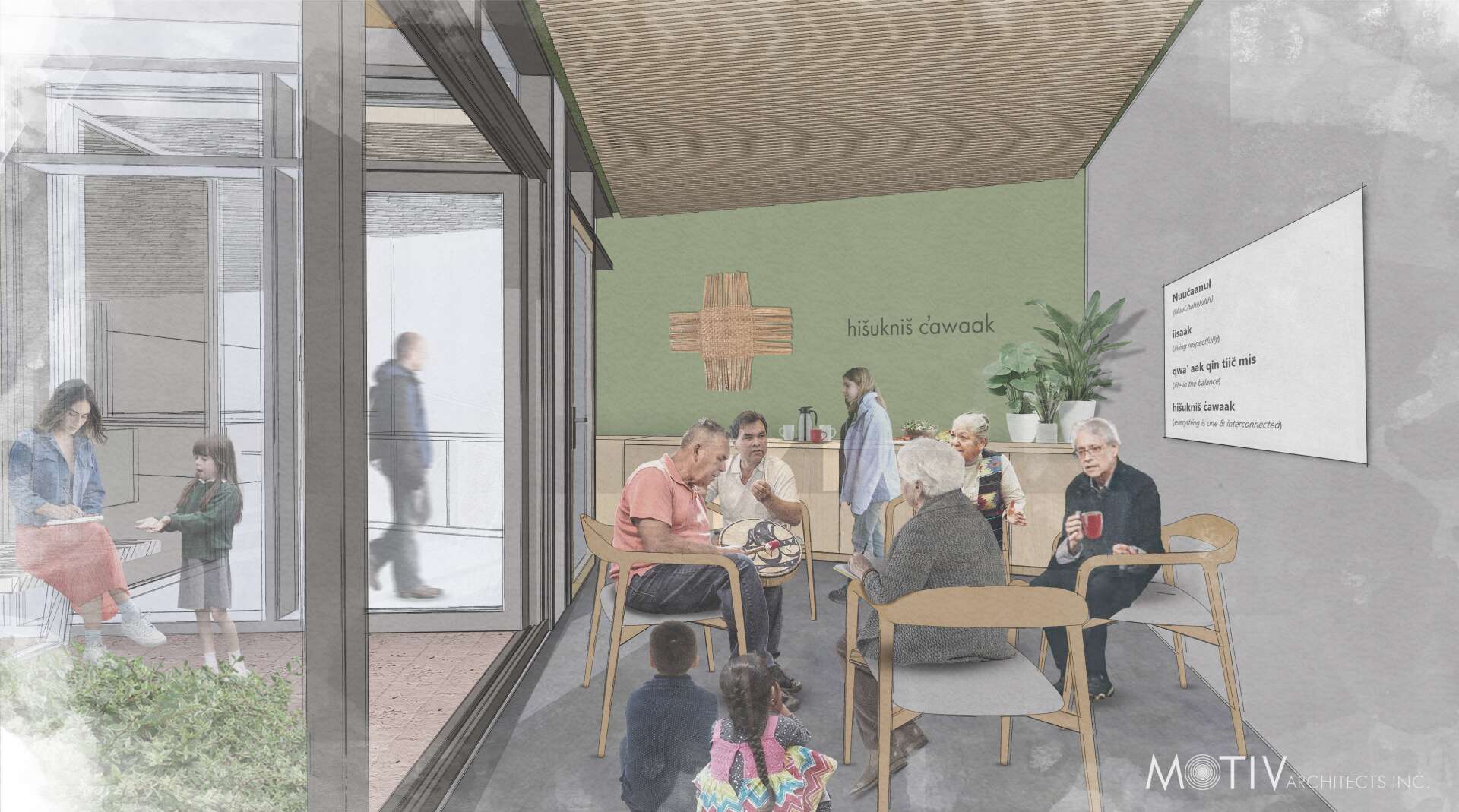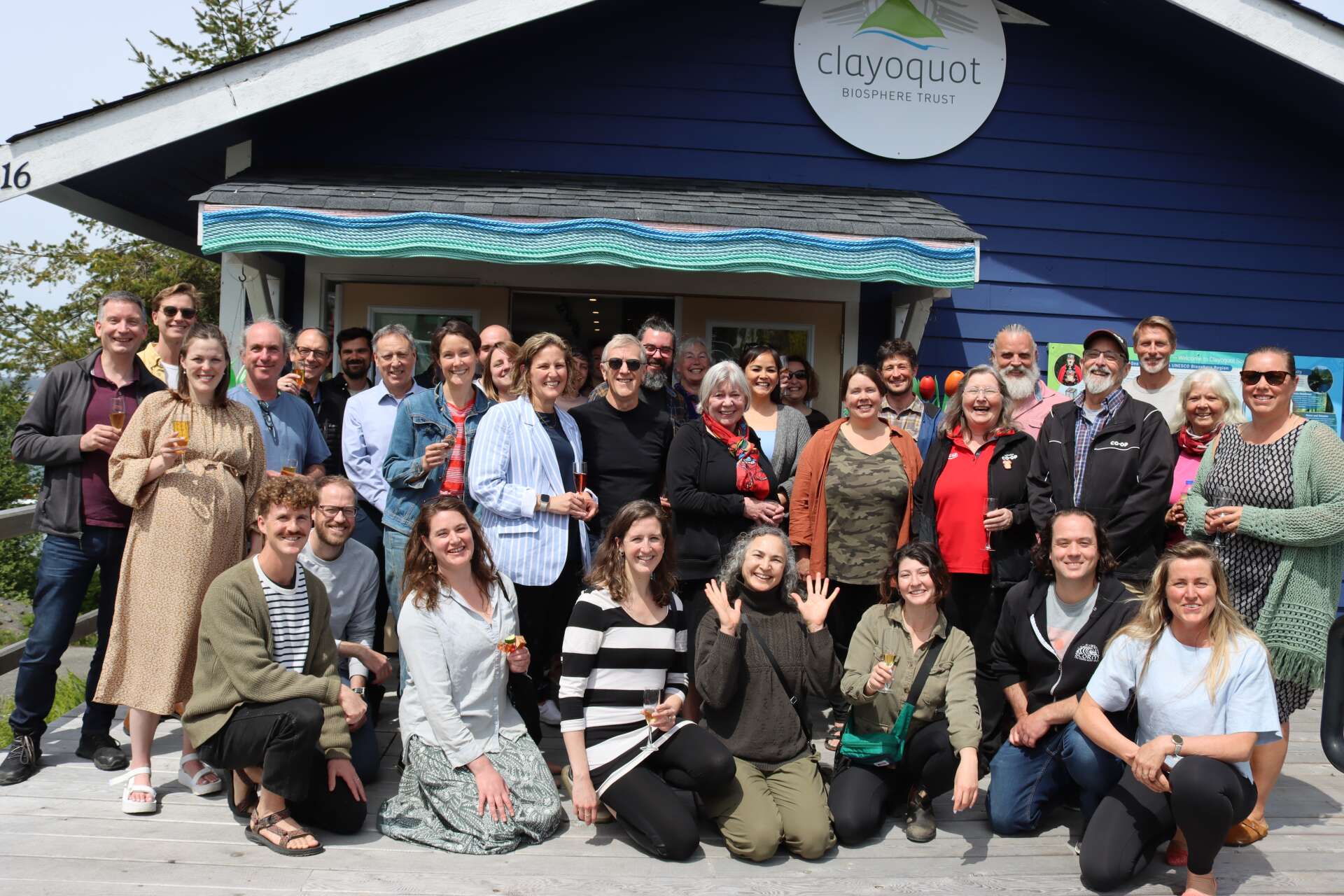Art as Reconciliation: The Clayoquot Sound Biosphere Centre’s Art Program
 Motiv Architects
Motiv Architects
By Michelle Hall & Robinson Cook
Nestled in the heart of the Clayoquot Sound UNESCO Biosphere Region, a transformative initiative from the Clayoquot Biosphere Trust (CBT) is redefining the role of public art in cultural renewal, place-making, and reconciliation. The Clayoquot Sound Biosphere Centre (CSBC), currently under development in Tla-o-qui-aht First Nations territory, is envisioned as a knowledge hub for education, research, and reconciliation. At the core of this vision is a groundbreaking Arts Program, one that doesn’t just decorate a space but infuses the region with meaning.
The CSBC Arts Program is structured around five thematic streams: rotating exhibitions, commissioned works, artist proposals, reclaimed and reused materials, and collaborative community art. The program is built through partnership with the five Nuu-chah-nulth communities in the region, along with Tofino and Ucluelet, and shaped by artists, Elders, and youth. It will be curated by a local West Coast artist and facilitated through a jury process that ensures representation from all Nations and communities in the Biosphere Region: Hesquiaht, Ahousaht, Tla-o-qui-aht, Yuułuʔiłʔatḥ, Toquaht, Tofino, and Ucluelet.
To keep the process open and inclusive, the curator and CBT team will visit each community to share details about the program and invite community members to participate as artists or jury members. The jury will include respected Elders, youth, and cultural leaders, each fairly compensated under national artist compensation standards.
In Nuu-chah-nulth culture, art is inseparable from culture, it is not made for decoration, galleries, or public display in the Western sense. Its roots are deeply embedded in tradition, ceremony, and identity. Some forms of artistic expression were never intended to be shared outside of sacred or ceremonial contexts. Through the CSBC Arts Program, we are working with communities to create space where cultural expression can be shared in ways that honour its origins. This means uplifting contemporary opportunities for visual storytelling while remaining sensitive to what is appropriate to share publicly. The program is designed to respect the cultural protocols that guide Nuu-chah-nulth art forms and ensure that Indigenous artists can create and lead without compromising cultural integrity.
“This program isn’t just about creating beautiful works of art,” says Robinson Cook, program curator. “It’s about creating opportunities, opportunities for connection, for expression, and for the community to shape the visual and cultural identity of a place we all care deeply about.”
The CSBC Arts Program is a $600,000 initiative. To date, CBT has secured $301,000 in total, including a $200,000 gift from the Audain Foundation and a $101,000 gift from the Susan Bloom Trust via the Victoria Foundation. The remaining funding depends on two additional funding applications submitted to the Canada Council for the Arts and the BC Arts Council. This growing support reflects strong momentum and deep belief in the program’s transformative impact.
What makes this program so powerful is its scope. Rather than placing a handful of artwork in a hallway, this initiative is embedding visual storytelling into the DNA of the building. Signature pieces include:
- Face of the Community Mural – A bold 17ft x 23ft mural painted on a cedar slat wall on the northeast exterior of the Centre. Created by Tla-o-qui-aht First Nation artists, this signature piece will serve as a visual expression of their deep relationship to land and territory.
- Two Welcome Figures – Carved by Tla-o-qui-aht artists, these monumental figures will honour Nuu-chah-nulth traditions of protocol, protection, and respect.
- Community Collaboration Wall – A 27ft x 10ft wall co-created by artists from all seven communities, placed in the Centre’s research space.
- Cedar Weaving Wall – A 22ft x 6ft wall of woven cedar bark, a critical artform in the history of Nuu-chah-nulth.
- Collaborative Overhang – A vibrant piece above the education space, symbolizing shared knowledge.
- Sky Weave – A kinetic sculpture responding to natural elements, representing identity and belonging.
- Spirits of the Coast – A ceiling sculpture in the stairwell exploring stories of land, sea, and spirit.
- The Four Elements – 4 sculptures suspended from the ceiling in the upstairs space, exploring earth, water, fire, and air.
- The Timeline Piece – An artwork chronicling the significant histories of Clayoquot Sound.
- Our Place – Our Piece Mosaic – A community-made mosaic of 500 tiles contributed through participatory workshops.
- Youth-Led Murals – Outdoor murals designed and painted by local youth, with mentor artist guidance.
Each of these artworks reflects something deeper than form or function. They tell stories and they create conversations.
In the current economic climate, it’s more difficult than ever for artists, particularly those in remote communities, to showcase and sell their work. The CSBC Arts Program provides critical infrastructure, mentorship, visibility, and paid opportunities to support creative careers along the West Coast. It’s not just about art; it’s about economic recovery and cultural resilience.
At a time when institutions are grappling with how to honour reconciliation in tangible ways, this project offers a model rooted in relationships. It recognizes that reconciliation is not a one-sided gesture. It’s about Indigenous and non-Indigenous people coming together, working together, and creating something together. The CSBC Art Program is reconciliation in action.
With an estimated 60,000 visitors annually, the Art Program has the potential to become one of the region’s most prominent and sought after public art platforms, offering a powerful and visible expression of culture, community, and place.
The Arts Program isn’t just about beautifying a space. It’s about restoring balance, recognizing the truth, and laying the foundation for what shared futures can look like when we choose to build them together.
With the Clayoquot Sound Biosphere Centre set to open at the end of 2026, the Arts Program is laying the groundwork for what reconciliation can look like when rooted in trust, collaboration, and creativity. It reminds us that the future isn’t something we wait for, it’s something we co-create, one tile, one mural, and one story at a time.
To learn more about the Clayoquot Sound Biosphere Centre, its current funding progress, the Arts Program, and the significance of the Clayoquot Sound UNESCO Biosphere Region, please visit www.clayoquotbiosphere.org. For inquiries, collaboration opportunities, or to support the project, contact Michelle Hall at michelle@clayoquotbiosphere.org.

